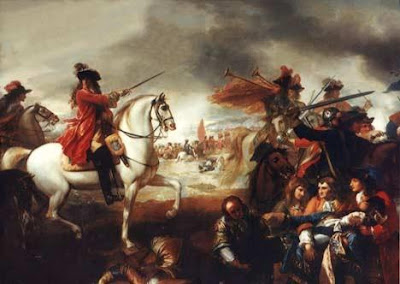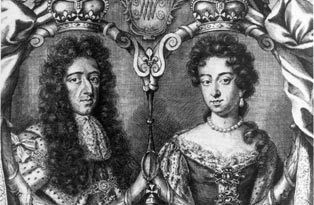Patrick Dun, physician to the army in Ireland
In 1688 Mary of Modena, the wife of the Catholic King James II gave birth to a son, James Francis Edward Stuart. This birth changed the line of succession to the British throne and created the very real prospect of a Catholic ruling dynasty. James II policy of religious tolerance had meet with increasing opposition from leading politicians. The birth of the Prince created a political alliance between Tories and Whigs, who invited William of Orange to England, to rule with his wife Mary, James II eldest daughter.
The political tensions in predominantly Catholic Ireland were high, and many leading Protestant left Ireland in 1688 and fled to England for safety. Amongst those recorded as fleeing Ireland was one 'Patr. Dun, Dr. Phys', the value of whose property was given as £130 annually, with another £70 from appointments, a totally yearly income of about £650,000 in today's money.[1] A year later Patrick Dun was back in Ireland, one of two doctors appointed to act as physicians to the armies of King William, which came to Ireland to suppress the Jacobite rising in favour of King James. Dun was with the army at Carrick-on-Suir and Limerick, he then returned to Dublin where he took up his duties as physicians to the Royal Hospital Kilmainham, which was the main hospital for war casualties.
 |
| The Battle of the Boyne |
In 1691 he wrote to the Secretary at War, George Clarke, who was stationed with the army outside Athlone sending him
'a box containing two dozen bottles of the best claret I could get in Dublin, and two dozen bottles of Chester ale … At the same time I sent a lesser box, in which there is a dozen and a half potted chickens in an earthen pot; and in another pot, four green geese. This is the best physic I advise you to take; I hope it will not be nauseous or disagreeable to your stomach – a little of it upon a march.'[2]
Dun's experiences the previous year of life with an army may well have influenced him in sending these parcels, being well aware of the quality of army food.
Dun's letters to George Clarke also record the problems of supplies and high numbers of war casualties in Dublin. Writing in August 1691 shortly after the victory at Athlone Dun stated that
'Last week the Hospital was so full of sick and wounded that we could not get beds for them … The men grumbled mightily for want of beds, therefore the Lord Justices ordered such as were so recovered of their wounds or sickness … to be quartered in the town. … I am informed by Dr Cummings that he is sending us between 2 and 300 sick and wounded from Athlone. If so many come we shall be necessitate to quarter many more in town ... We are also daily wanting some utensils; about ten pounds sterling will suffice for present necessity … Sir, we have at present in hospital 959 sick and wounded, most wounded. We have not a master chirurgeon with us … it will be impossible for Dr Le Can and me to visit once a day all the sick.'[3]
Dun was so concerned at the shortage of supplies and money that he desired that his own pay should be left until all other necessary expenses had been paid, decades later his widow was still trying to reclaim his unpaid salary from this time.
Dun's flight from Ireland may have temporarily halted his rise in the medical profession, but his return with the, ultimately victorious, Williamite armies insured that he swiftly regained all that he had lost in his flight. In 1690 Dun was re-elected as President of the College of Physicians in Dublin, and two years later would use his political influence to gain the College its second Royal Charter.
 |
| King William and Queen Mary |
[2] Letter from Patrick Dun to George Clarke quoted in Widdess, History of the Royal College of Physicians of Ireland, p.31
[3] Letter from Patrick Dun to George Clarke quoted in Widdess, History of the Royal College of Physicians of Ireland, p.31-2.